Teff presents a unique opportunity for athletes and active individuals to discover a new competitive edge - not only for athletic performance but also, and importantly, for overall health and wellbeing.
Teff, scientifically known as Eragrostis tef, is a tiny but mighty grain with ancient origins rooted in the Horn of Africa, specifically Ethiopia and Eritrea. It’s a grass that uses 10x less water than wheat to grow and for over 3,000 years it has been a cornerstone of traditional diets and a symbol of cultural heritage in these regions.
In recent years, teff has transitioned from a local treasure to gaining international recognition as a nutritional powerhouse. It is often referred to as a superior fuel for active individuals and has been hailed as the "runner's super food" given the winning tradition of Ethiopian marathoners.
While teff has been fuelling elite athletes and everyday warriors in its native East Africa for millennia, it's now making its mark in the Western world as the must-have grain for performance nutrition.
Teff - The ancient grain that outperforms other staples. Teff stands out as a nutritional all-star when compared to other popular grains like wheat, rice, and quinoa.
One of the most remarkable features of teff is its amino acid profile, offering a complete set of essential amino acids, which is rare among plant-based foods. In contrast, grains like wheat and rice lack certain essential amino acids, making them incomplete protein sources.
The mineral content of teff is another area where it outshines its counterparts. Teff is an excellent source of calcium, providing approximately 123 mg per cup, which is significantly more than wheat (~22 mg per cup) and brown rice (~20 mg per cup).
It's also rich in iron, with around 5 mg per cup, compared to quinoa's 2.8 mg and wheat's 1.4 mg per cup. Additionally, teff is low in phytic acid* meaning that the iron from teff is more easily absorbed by the body.
*phytic acid is an inhibitor of iron absorption meaning that the iron in teff can be better absorbed than the iron in other plant-based sources.
Teff also boasts an impressive fibre content, which contributes to better gut and cardiovascular health, as well as helping to
manage blood sugar levels [1]. While a cup of cooked quinoa contains about 5 grams of dietary fibre, teff provides around 7–8 grams per cup. In comparison, white rice falls far short, offering only about 0.6 grams of fibre per cup.
10 Reasons to Include Teff Within Your Diet
Whether you're an athlete looking for an edge, a fitness enthusiast wanting to up your game, or just someone interested in enhancing your health, teff offers a nutritionally-packed solution to elevate your diet and overall well-being.
1. Sustained energy
Teff is made up of 20-40% resistant starch and is low on the glycemic index. When teff is consumed, it releases its energy slowly helping to provide a consistent energy source over a prolonged period of time. A steady supply of energy, such as that provided by teff, may help prevent energy crashes and sustain both mental and physical performance.
2. Impressive nutrient profile
Teff is a favourite grain of elite endurance athletes because of its impressive nutritional profile. Teff contains calcium, iron, copper, magnesium, manganese, phosphorus, potassium, and zinc. It is also a good source of antioxidant polyphenols and is the only ancient grain to contain vitamin C.
3. Gut health
Due to its high fibre, micronutrient and resistant starch content, the inclusion of teff into the daily diet teff may contribute towards a healthy gut microbiome. 20-40% of teff’s carbohydrate content is resistant starch which isn’t absorbed by the body but instead acts as a prebiotic, feeding good bacteria in the gut [2].
4. Micronutrient absorption
Teff contains high amounts of ferric, caffeic, and protocatechuic, which have been shown to improve micronutrient absorption [2].
5. Complete Protein
Teff is almost unique among grains for being a “complete” protein, meaning that it provides all nine essential amino acids required for human nutrition. This makes teff a particularly attractive option for athletes and health-conscious consumers, as well as vegetarians and vegans who might struggle to source all essential amino acids from other plant-based foods.
6. Gluten-Free
Teff is naturally gluten-free, making it an ideal option for those with gluten sensitivities or celiac disease. While other gluten-free grains like rice and quinoa are available, teff's nutritional superiority (or ‘completeness’) gives it an edge.
7. Weight Management
Using teff as a vehicle to increasing dietary fibre intake may enhance satiety (feelings of fullness) and aid in long-term weight management. The fibre increases the viscosity of stomach contents, thereby prolonging digestion and increasing feelings of fullness [7,8].
8. A new way to boost your “plant-points”
Adding teff to your diet offers a natural and effective way of increasing your "plant points”, which is beneficial for both your personal health and the health of the planet.
9. A grain for the future
As well as being great for human health, teff is a good crop for the planet. Although teff uses more space per kilo yield of wheat, it uses far less water, is a hardy crop that can grow in poor soils, and requires no pesticides or chemical fertilisers. According to the United Nations Food and Agricultural Organisation, 75% of the world's food currently comes from just 12 plants and 5 animal species [13]. Increasing the widespread use of teff has the potential to improve food security, ensuring diversity across the food chain and reliance on resilient crops.
10. The Teff Bites Solution
Over the past five years, we’ve worked hard to create a healthy, delicious and convenient way for anybody to incorporate the benefits of teff into their daily diet. Our Teff Superblend Bites are the ultimate on-the-go snack for nourishing wellbeing and performance, everyday.
Teff Superblend Bites
Fusing innovation with tradition, Superblend Bites are the ultimate permissible indulgence. They are gluten-free, plant-based, high in fibre, and made with nothing artificial.
Superblend Bites deliver a good source of slowly digested carbohydrates, fibre to support gut health, and micronutrients such as iron, manganese and phosphorous that all play key roles in several biological processes important to the athlete, and everyday wellbeing.
Our Bites are baked in our own UK-based factory, and our ingredients are sustainably and responsibly sourced to amplify impact across the supply chain.
Your new high performance habit
Teff Bites are more than just a snack—they're a daily ritual for a high performance life. Whether you're crushing it at the gym, leading back-to-back meetings, or chasing after the kids, Superblend Bites provide the sustained energy and nutritional benefits your body needs to perform at its best, every day.
Delicious, convenient, and crafted from all-natural ingredients, Superblend Bites are the perfect complement to a balanced diet.
The smart on-the-go snack. Superblend Bites fit perfectly into busy lifestyles - as a quick source of fuel before a gym session, a mid-morning or mid-afternoon pick-me-up, as a healthy snack for busy parents or children on-the-go, or as a nourishing late night indulgence. Superblend Bites are an incredibly versatile choice that caters to busy lifestyles without the addition of ultra-processed ingredients. They are the smart alternative to ultra-processed snacking without mountains of meal-prep and planning.
Written by Dr Scott Robinson, The Edge HPL
References
[1] Slavin, J. (2013). Fiber and prebiotics: Mechanisms and health benefits. Nutrients, 5(4), 1417–1435. DOI:10.3390/nu5041417
[2] Alterations in the Intestinal Morphology, Gut Microbiota, and Trace Mineral Status Following Intra-Amniotic Administration (Gallus gallus) of Teff (Eragrostis tef) Seed Extracts. Carboni et al, Nutrients 2020, 12(10), 3020; https://doi.org/10.3390/nu12103020
[3] Microbiome and Nutrient Absorption: Turnbaugh, P.J., Ley, R.E., Hamady, M., Fraser-Liggett, C.M., Knight, R., & Gordon, J.I. (2007). The Human Microbiome Project. Nature, 449(7164), 804–810.
[4] Gut Health and Immune System: Belkaid, Y., & Hand, T.W. (2014). Role of the microbiota in immunity and inflammation. Cell, 157(1), 121-141.
[5] Gut-Brain Axis: Mayer, E.A., Tillisch, K., & Gupta, A. (2015). Gut/brain axis and the microbiota. The Journal of Clinical Investigation, 125(3), 926-938.
[6] Metabolic Regulation: Ridaura, V.K., Faith, J.J., Rey, F.E., Cheng, J., Duncan, A.E., Kau, A.L., ... & Gordon, J.I. (2013). Gut microbiota from twins discordant for obesity modulate metabolism in mice. Science, 341(6150), 1241214.
[7] Effects of Dietary Fibre on Subjective Appetite, Energy Intake and Body Weight: A Systematic Review of Randomized Controlled Trials" published in Obesity Reviews, 2011, DOI: 10.1111/j.1467-789X.2011.00895.x.
[8] Satiety and energy intake after single and repeated exposure to gel-forming dietary fiber: post-ingestive effects" published in the International Journal of Obesity, 2015, DOI: 10.1038/ijo.2015.3.
[9] Plant-based diets: Considerations for environmental impact, protein quality, and exercise performance" published in Nutrients, 2018, DOI:10.3390/nu10121844.
[10] Plant-Based Diets Are Associated With a Lower Risk of Incident Cardiovascular Disease, Cardiovascular Disease Mortality, and All-Cause Mortality in a General Population of Middle-Aged Adults" published in the Journal of the American Heart Association, 2019, DOI: 10.1161/JAHA.119.012865
[11] Gut microbiota richness promotes its stability upon increased dietary fiber intake in healthy adults" published in Environmental Microbiology, 2015, DOI: 10.1111/1462-2920.13006.
[12] Reducing food’s environmental impacts through producers and consumers" published in Science, 2018, DOI: 10.1126/science.aaq0216.
[13] Building on gender, agrobiodiversity and local knowledge. FAO


